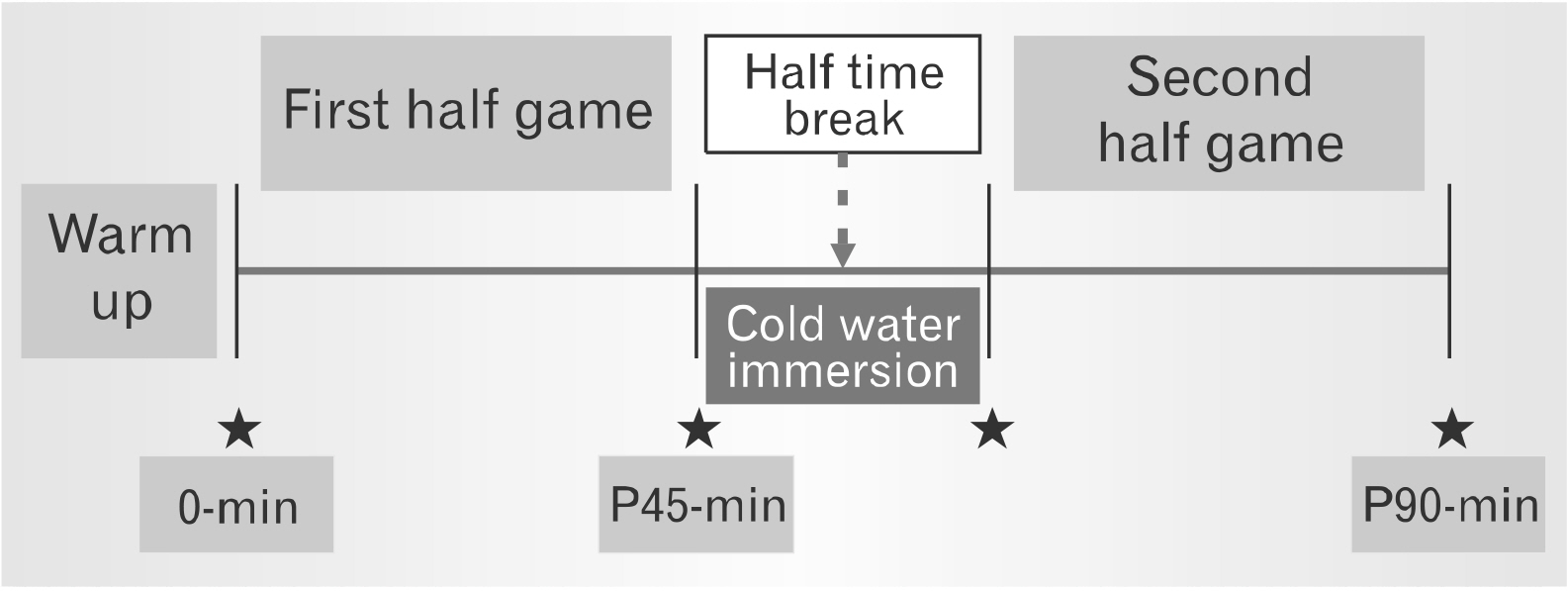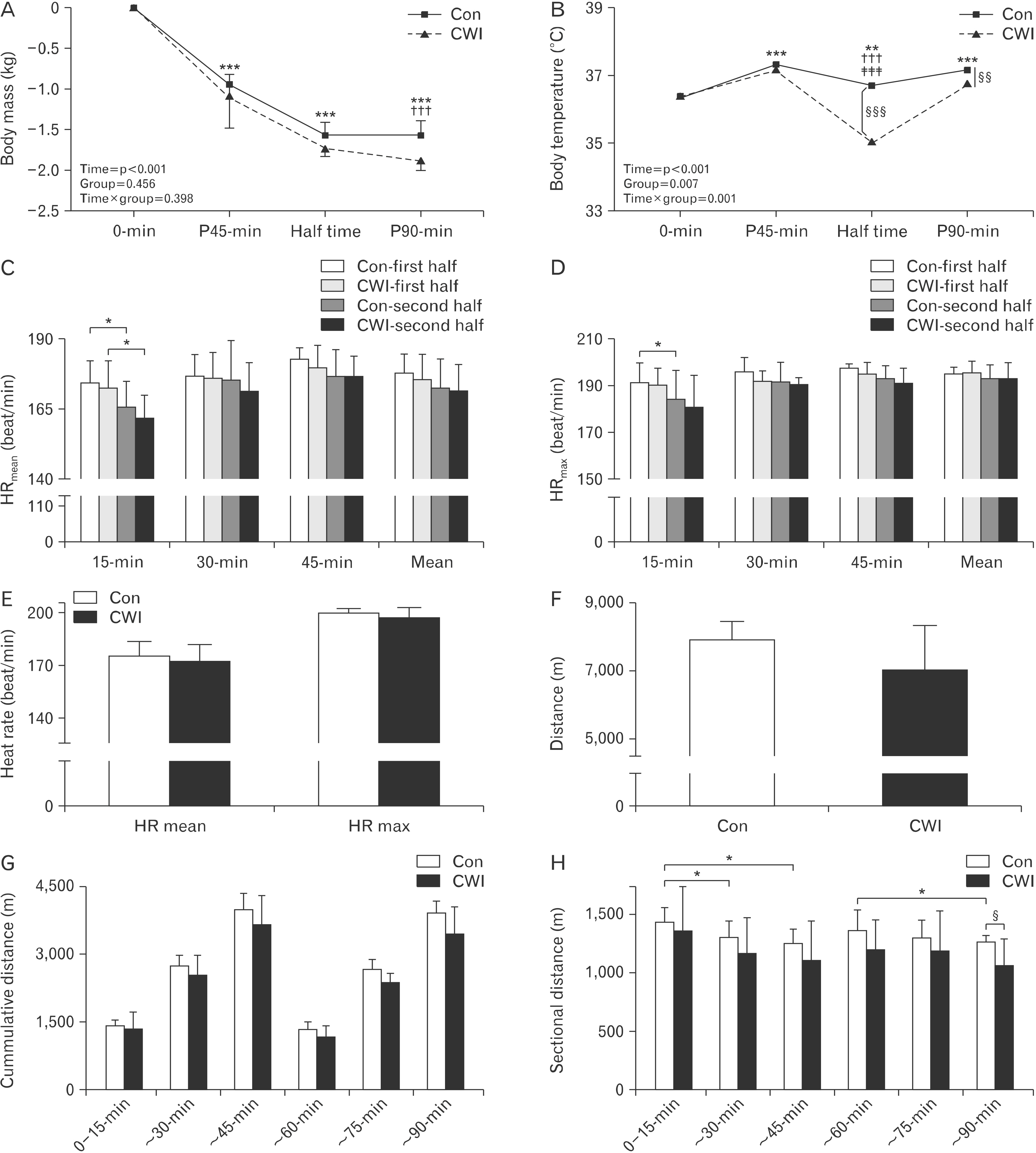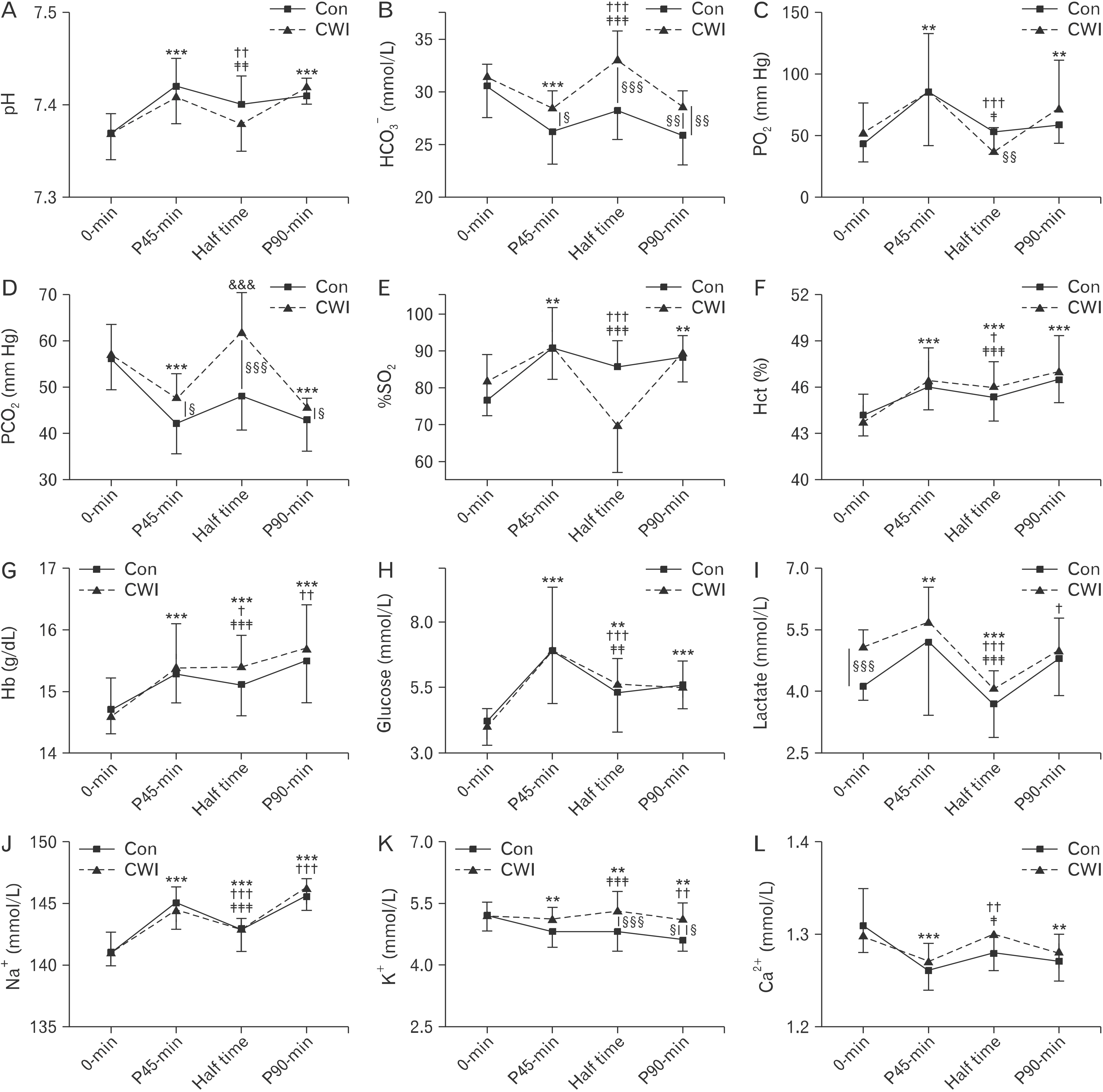Korean J Sports Med.
2021 Dec;39(4):170-180. 10.5763/kjsm.2021.39.4.170.
The Effect of Cold Water Immersion on Physiological Indices, Inflammatory and Immune Responses during a Soccer Match
- Affiliations
-
- 1Department of Physical Education, Daegu University, Gyeongsan, Korea
- 2Department of Physical Education, Yeungnam University, Gyeongsan, Korea
- 3Korea Football Association, SeoulMadisesang Hospital, Seoul, Korea
- 4Madisesang Hospital, Seoul, Korea
- KMID: 2523232
- DOI: http://doi.org/10.5763/kjsm.2021.39.4.170
Abstract
- Purpose
We investigated the effects of cold water immersion (CWI) treatment during half-time break on performance related physiological indices during second half soccer match.
Methods
Twenty-two collegiate soccer players participated in the study. Subjects undertook 3 minutes head out seated with whole body immersion at 19 o C to 21 o C. Total four venous blood samples were collected and analyzed for markers of ionic regulations and inflammatory (interleukin [IL]-1b, IL-6, IL-8, IL-10, tumor necrosis factor-α , and vascular endothelial growth factor) and immune functions (immunoglobulin [Ig] G, IgG2, IgG2, IgG3, IgG4, IgA, and IgM).
Results
Partial oxygen concentration and %SO 2 level was lowered in CWI. Hemoglobin and hematocrit values were not significantly different between experimental groups. While there was no notable effect was shown in Na + and Ca 2+ , K + concentration was higher in CWI during second half match. There were no effects in any of inflammatory and/or anti-inflammatory cytokines and Ig.
Conclusion
These results suggest that CWI during half time break exert positively affects in buffering capacity and promote oxygen delivery to the actively recruited skeletal muscle, possibly results in improve soccer performance during second half match.
Keyword
Figure
Reference
-
1. Stølen T, Chamari K, Castagna C, Wisløff U. 2005; Physiology of soccer: an update. Sports Med. 35:501–36. DOI: 10.2165/00007256-200535060-00004. PMID: 15974635.2. Hoff J. 2005; Training and testing physical capacities for elite soccer players. J Sports Sci. 23:573–82. DOI: 10.1080/02640410400021252. PMID: 16195006.
Article3. Mohr M, Krustrup P, Bangsbo J. 2003; Match performance of high-standard soccer players with special reference to development of fatigue. J Sports Sci. 21:519–28. DOI: 10.1080/0264041031000071182. PMID: 12848386.
Article4. Malta ES, Dutra YM, Broatch JR, Bishop DJ, Zagatto AM. 2021; The effects of regular cold-water immersion use on training-induced changes in strength and endurance performance: a systematic review with meta-analysis. Sports Med. 51:161–74. DOI: 10.1007/s40279-020-01362-0. PMID: 33146851.
Article5. Brandner B, Munro B, Bromby LM, Hetreed M. 1996; Evaluation of the contribution to postoperative analgesia by local cooling of the wound. Anaesthesia. 51:1021–5. DOI: 10.1111/j.1365-2044.1996.tb14995.x. PMID: 8943591.
Article6. Peiffer JJ, Abbiss CR, Watson G, Nosaka K, Laursen PB. 2010; Effect of a 5-min cold-water immersion recovery on exercise performance in the heat. Br J Sports Med. 44:461–5. DOI: 10.1136/bjsm.2008.048173. PMID: 18539654.
Article7. Ascensão A, Leite M, Rebelo AN, Magalhäes S, Magalhäes J. 2011; Effects of cold water immersion on the recovery of physical performance and muscle damage following a one-off soccer match. J Sports Sci. 29:217–25. DOI: 10.1080/02640414.2010.526132. PMID: 21170794.
Article8. Siegel R, Maté J, Watson G, Nosaka K, Laursen PB. 2012; Pre-cooling with ice slurry ingestion leads to similar run times to exhaustion in the heat as cold water immersion. J Sports Sci. 30:155–65. DOI: 10.1080/02640414.2011.625968. PMID: 22132792.
Article9. Reilly T, Williams AM. Science and soccer. 2nd ed. Routledge;London: 2003. p. 21–46. DOI: 10.4324/9780203417553.10. Kim CH, Kim JH, Kim HJ, Ahn HC, Im JH, Kim C. 2007; Time-motion analysis on activity patterns of professional soccer players. Korean J Phys Educ. 46:407–15.11. Krustrup P, Mohr M, Steensberg A, Bencke J, Kjaer M, Bangsbo J. 2006; Muscle and blood metabolites during a soccer game: implications for sprint performance. Med Sci Sports Exerc. 38:1165–74. DOI: 10.1249/01.mss.0000222845.89262.cd. PMID: 16775559.12. Roberts LA, Nosaka K, Coombes JS, Peake JM. 2014; Cold water immersion enhances recovery of submaximal muscle function after resistance exercise. Am J Physiol Regul Integr Comp Physiol. 307:R998–1008. DOI: 10.1152/ajpregu.00180.2014. PMID: 25121612.
Article13. Mohr M, Nybo L, Grantham J, Racinais S. 2012; Physiological responses and physical performance during football in the heat. PLoS One. 7:e39202. DOI: 10.1371/journal.pone.0039202. PMID: 22723963. PMCID: PMC3378691.
Article14. Tomlin DL, Wenger HA. 2001; The relationship between aerobic fitness and recovery from high intensity intermittent exercise. Sports Med. 31:1–11. DOI: 10.2165/00007256-200131010-00001. PMID: 11219498.
Article15. Christiansen D, Bishop DJ, Broatch JR, Bangsbo J, McKenna MJ, Murphy RM. 2018; Cold-water immersion after training sessions: effects on fiber type-specific adaptations in muscle K+ transport proteins to sprint-interval training in men. J Appl Physiol (1985). 125:429–44. DOI: 10.1152/japplphysiol.00259.2018. PMID: 29745801.
Article16. Boutilier RG. 2001; Mechanisms of cell survival in hypoxia and hypothermia. J Exp Biol. 204(Pt 18):3171–81. DOI: 10.1242/jeb.204.18.3171. PMID: 11581331.
Article17. Peake J, Nosaka K, Suzuki K. 2005; Characterization of inflammatory responses to eccentric exercise in humans. Exerc Immunol Rev. 11:64–85. PMID: 16385845.18. Tipton MJ, Collier N, Massey H, Corbett J, Harper M. 2017; Cold water immersion: kill or cure? Exp Physiol. 102:1335–55. DOI: 10.1113/EP086283. PMID: 28833689.
Article19. Rowsell GJ, Coutts AJ, Reaburn P, Hill-Haas S. 2009; Effects of cold-water immersion on physical performance between successive matches in high-performance junior male soccer players. J Sports Sci. 27:565–73. DOI: 10.1080/02640410802603855. PMID: 19308790.
Article20. Siqueira AF, Vieira A, Bottaro M, et al. 2018; Multiple cold-water immersions attenuate muscle damage but not alter systemic inflammation and muscle function recovery: a parallel randomized controlled trial. Sci Rep. 8:10961. DOI: 10.1038/s41598-018-28942-5. PMID: 30026562. PMCID: PMC6053395.
Article21. Andersson H, Bøhn SK, Raastad T, Paulsen G, Blomhoff R, Kadi F. 2010; Differences in the inflammatory plasma cytokine response following two elite female soccer games separated by a 72-h recovery. Scand J Med Sci Sports. 20:740–7. DOI: 10.1111/j.1600-0838.2009.00989.x. PMID: 19765242.
Article22. Weinstock C, König D, Harnischmacher R, Keul J, Berg A, Northoff H. 1997; Effect of exhaustive exercise stress on the cytokine response. Med Sci Sports Exerc. 29:345–54. DOI: 10.1097/00005768-199703000-00009. PMID: 9139173.
Article23. Handzlik MK, Shaw AJ, Dungey M, Bishop NC, Gleeson M. 2013; The influence of exercise training status on antigen-stimulated IL-10 production in whole blood culture and numbers of circulating regulatory T cells. Eur J Appl Physiol. 113:1839–48. DOI: 10.1007/s00421-013-2614-y. PMID: 23435500.
Article24. McKune AJ, Smith LL, Semple SJ, Mokethwa B, Wadee AA. 2006; Immunoglobulin responses to a repeated bout of downhill running. Br J Sports Med. 40:844–9. DOI: 10.1136/bjsm.2006.027839. PMID: 16920774. PMCID: PMC2465050.
Article25. Janský L, Pospísilová D, Honzová S. 1996; Immune system of cold-exposed and cold-adapted humans. Eur J Appl Physiol Occup Physiol. 72:445–50. DOI: 10.1007/BF00242274. PMID: 8925815.
Article
- Full Text Links
- Actions
-
Cited
- CITED
-
- Close
- Share
- Similar articles
-
- Changes of Brachial Arterial Doppler Waveform during Immersion of the Hand of Young Men in Ice-cold Water
- New Rat Model for the Research of Stress Ulcer Accompanying Subarachnoid Hemorrhage
- A Case of Acute Kidney injury After Seawater Immersion
- The Effect of Local Heating on the Hunting Reactions of Korean Subjects
- Change of fracture mode of orthodontic resin bracket wings under water immersion and thermocycling




